Berlin 1967 and 2012
BERLIN 1967 and 2012
In 1967-68 I spent two years in Germany, living in Düsseldorf and travelling all over the country on business. During this period I went to Berlin four times, once for a long weekend by car and otherwise by air for day visits to customers.
This was the height of the Cold War. Germany was still divided into East and West zones, the East being controlled by Russia, and the West still occupied by British, American and French troops, although there was complete freedom of movement in the West and it was essentially self-governing.
Berlin was not part of East or West Germany, it was a sovereign city, divided into four sectors directly administered by the four above-mentioned powers. It was totally surrounded by East German territory, over 100 miles from the West German border, and connected to the west by a small number of road and rail routes. From time to time the Russians would close these routes for a few hours, just to show that they could, in the face of strong protests from the Allies.
At Easter 1967 I drove to Berlin on the autobahn through East Germany from Helmstedt (Checkpoint A) to Dreilinden (Checkpoint B) . There were strict rules about not stopping, not leaving the main route, and taking too much or too little time for the journey. If you took too long you would be questioned about what you had been doing, and if you got there too soon you would be fined for speeding! Despite this, West Germans were known to hold brief meetings with East German relatives on the laybys along the route.
There was a tension in the atmosphere in Berlin that it is impossible to describe, brought about by the feeling of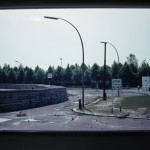 insecurity. Until1961 there was free movement between the sectors of the city, but so many people were leaving the east to live in the west that the Russians put up a physical barrier between their sector and the rest of the city. At first it was just a wire fence, but it was very quickly changed to a wall which itself was substantially reinforced as time went on. In 1967 foreigners and West Germans could visit East Berlin, but West Berliners could not.
insecurity. Until1961 there was free movement between the sectors of the city, but so many people were leaving the east to live in the west that the Russians put up a physical barrier between their sector and the rest of the city. At first it was just a wire fence, but it was very quickly changed to a wall which itself was substantially reinforced as time went on. In 1967 foreigners and West Germans could visit East Berlin, but West Berliners could not.
Because of the uncertainty there was little investment in the city, and many young people moved to West Germany. As an incentive to try to combat the aging population young German males could avoid conscription by going to live in Berlin.
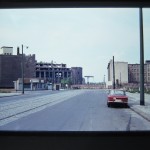 Many West Berliners did not bother to have a car, because there was nowhere that they could go in it without driving right across to West Germany. In 1967 it was possible to park at the roadside almost anywhere in the city centre without paying.
Many West Berliners did not bother to have a car, because there was nowhere that they could go in it without driving right across to West Germany. In 1967 it was possible to park at the roadside almost anywhere in the city centre without paying.
My secretary knew a West German girl who had a boyfriend in East Berlin and went through the border quite frequently to visit him, so it was arranged that she would take me into the Russian sector for a day while I was in the city. The normal way for foreigners to go through the wall on foot or in vehicles was at Checkpoint C, better known as the famous Checkpoint Charlie, a control point between the American and Russian sectors in Friedrichstrasse, near the city centre. However, because we went on the underground we crossed over in Friedrichstrasse Station, which entailed pushing our passports into a slot followed by a nerve-racking wait while they were processed by someone who would decide whether or not we could go through and continue the train journey.
It is now greatly to my regret that I did not take any photographs in East Berlin, but I think perhaps I was worried about getting arrested for spying or something, because I took photographs only on the western side of the Wall. My main memories are of two-stroke cars and vans producing clouds of blue smoke, state-owned restaurants called Mitropa, with dreadful coffee, and a general atmosphere of austerity. At the time mini-skirts were the height of fashion in the west, and I commented on the fact East German girls all still had long skirts, to which my companion replied “They can’t get the material”. It was difficult to think of an answer to that.
Forward to 2012. Sunday.
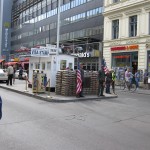 From Schönefeld Airport I travelled partly by S-bahn (a sort of underground railway that runs above ground) and partly by proper underground, to the city centre, and came up right at Checkpoint Charlie. The cheap hotel that I had booked was called “Hotel Lebensquelle am Checkpoint Charlie”, although it was quite some distance from the checkpoint, and I quickly realised that any business within 500 yards of the checkpoint describes itself as “at Checkpoint Charlie”. The former checkpoint is a massive tourist attraction, with buses and coaches disgorging tourists who rush over to the sentry post in the middle of the road to be photographed alongside the American soldiers on duty. It is highly unlikely that the men in uniform are actually American or soldiers, and the sentry post is definitely not genuine, the original having been taken away to a museum years ago.
From Schönefeld Airport I travelled partly by S-bahn (a sort of underground railway that runs above ground) and partly by proper underground, to the city centre, and came up right at Checkpoint Charlie. The cheap hotel that I had booked was called “Hotel Lebensquelle am Checkpoint Charlie”, although it was quite some distance from the checkpoint, and I quickly realised that any business within 500 yards of the checkpoint describes itself as “at Checkpoint Charlie”. The former checkpoint is a massive tourist attraction, with buses and coaches disgorging tourists who rush over to the sentry post in the middle of the road to be photographed alongside the American soldiers on duty. It is highly unlikely that the men in uniform are actually American or soldiers, and the sentry post is definitely not genuine, the original having been taken away to a museum years ago.
Facing the “Americans” is a picture of a stern-looking young Russian border guard and a sign stating YOU ARE LEAVING THE AMERICAN SECTOR, which may be original. This is all part of the huge industry that has built up around the Berlin Wall and other ramifications of the Cold War.
Most of the Wall has gone, but the line of it is marked for much of its length with a double row of cobbles set into the ground, and this led to within a few yards of my hotel. Before booking I had read the reviews and it seemed to be all right, although there were some slightly odd remarks like “The staff did not smile, but that was not because they were unpleasant, it was because they were Russian”.
Before the war the city centre was in the area around Alexanderplatz, which finished up in the Russian sector. After the division West Berlin developed its own centre around the Kurfürstendamm, a main thoroughfare well to the west of the Wall.
It was Sunday afternoon and after checking in with the unsmiling staff at the Lebensquelle I went to look at the old city centre as it was not too far to walk. It is 23 years since the Wall came down and a lot has happened since then, with many new buildings going up and old ones being restored, but there are still signs of the utilitarian style that characterised Eastern Europe under Communist rule. Alexanderplatz and the surrounding area was bustling with life and, unbelievably, THE SHOPS WERE OPEN ON SUNDAY AFTERNOON! IN GERMANY!
to walk. It is 23 years since the Wall came down and a lot has happened since then, with many new buildings going up and old ones being restored, but there are still signs of the utilitarian style that characterised Eastern Europe under Communist rule. Alexanderplatz and the surrounding area was bustling with life and, unbelievably, THE SHOPS WERE OPEN ON SUNDAY AFTERNOON! IN GERMANY!
However, in other ways Germany is still Germany, and close to Alexanderplatz was one of the enormous building sites to be found elsewhere in Berlin and all German cities, in this case for the construction of a new underground line close to the surface. In the 45 years that I have been going to Düsseldorf I can never remember a time when the city has not been massively disrupted by one civil engineering project or another. If you say anything to the locals they say “Ah, yes, but it will be lovely when it is 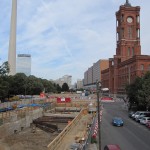 finished”. The problem is that it never is finished, because as soon as they complete that project they start another and even if you cannot imagine anything else that needs to be done they will think something up.
finished”. The problem is that it never is finished, because as soon as they complete that project they start another and even if you cannot imagine anything else that needs to be done they will think something up.
Most of the well-known German retail outlets had branches in Alexanderplatz, but I was rather amused to see that Primark are opening there shortly. That will shake things up a bit, because at the bottom end the clothing sector is less competitive than in Britain.
Close to Alexanderplatz is the imposing TV tower, built in the 1970s, and until recently the tallest structure in the EU. It has just been surpassed by The Shard in London.
Also not far away is the Nicholaiviertel, (Nicholai quarter), an ‘old town’ area. Despite the difficult conditions in the years after the war the Germans set about rebuilding most of their old city centres in the original style, and when you wander about the ‘Altstadt’ areas of Nurnberg or Düsseldorf it is hard to believe that they are really only about 60 years old. Originally the East Germans did not restore most of what was left of the old buildings, in fact they demolished them and replaced them with the uninspiring architecture of the period. In the 1960s they had a change of mind and decided to build the Nicholai Quarter, a small conglomeration of old-style buildings that are not particularly convincing.
set about rebuilding most of their old city centres in the original style, and when you wander about the ‘Altstadt’ areas of Nurnberg or Düsseldorf it is hard to believe that they are really only about 60 years old. Originally the East Germans did not restore most of what was left of the old buildings, in fact they demolished them and replaced them with the uninspiring architecture of the period. In the 1960s they had a change of mind and decided to build the Nicholai Quarter, a small conglomeration of old-style buildings that are not particularly convincing.
On the way back to the hotel I discovered a marvellous museum of East German motorcycles, open until 10pm, and the DDR museum, also open late. This is dedicated to life in the DDR (German Democratic Republic, the Russian dominated East German state), and covers all aspects of the period between 1945 and 1989, from politics through to domestic practicalities. There were samples of the branded goods of the time, mostly state-produced, and a mock-up of a typical dwelling, with period furniture and fittings. Many people were laughing at this, but actually I thought quite a lot of it bore a resemblance to my own house.
The route took me for a short distance along Unter den Linden, the wide avenue lined with fine buildings intended to rival the Champs d’Elysee in Paris. The East Germans did restore those buildings to the original style, but they have a strange sterile look about them, although some big names are moving in and the intention is clearly to make it the most prestigious thoroughfare in the city again. It is not helped by much of its length being a building site for the new underground, and this work has been going on for years.
Monday
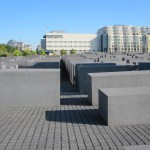 The next day I had booked a visit to the glass dome on the Reichstag building at 10.00am. On the way I came across the recently constructed Holocaust Memorial, consisting of 2711 dark coloured rectangular marble blocks of different sizes placed in rows over a large area at the roadside. It was designed by a Jewish American architect, and seems a strange format for a memorial, but as I gazed down into the dark gaps between the stones on a bright sunny morning I felt that it was very effective.
The next day I had booked a visit to the glass dome on the Reichstag building at 10.00am. On the way I came across the recently constructed Holocaust Memorial, consisting of 2711 dark coloured rectangular marble blocks of different sizes placed in rows over a large area at the roadside. It was designed by a Jewish American architect, and seems a strange format for a memorial, but as I gazed down into the dark gaps between the stones on a bright sunny morning I felt that it was very effective.
After a quick look at the Brandenburg Gate I arrived at the Reichstag building, which is now once again the seat of the German parliament, and quickly joined a group for admission to the glass dome. The building had a dome until the 1960s, when it was removed during a period of rebuilding, and a new dome was designed at the end of the last century by Lord Foster. It is far from just a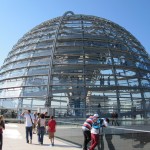 glass dome, but a high-tech engineering construction to control the environment inside the building. There is a 230m long spiral ramp leading to a platform near the top, from which there are spectacular views in all directions over the city. A more perfect day for this visit could not be imagined, with a totally cloudless sky. The top of the dome is open to the elements with a large hole through which hot air goes out in the summer and rain and snow beat in during the winter, but there is some cunning arrangement whereby the water is channelled away before it gets through to the
glass dome, but a high-tech engineering construction to control the environment inside the building. There is a 230m long spiral ramp leading to a platform near the top, from which there are spectacular views in all directions over the city. A more perfect day for this visit could not be imagined, with a totally cloudless sky. The top of the dome is open to the elements with a large hole through which hot air goes out in the summer and rain and snow beat in during the winter, but there is some cunning arrangement whereby the water is channelled away before it gets through to the 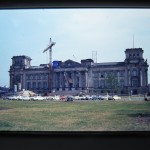 parliamentary chamber below.
parliamentary chamber below.
From this point on I revisited the sites I had photographed in 1967, and the photos from that time are on the left of the text below, and those from 2012 are on the right. Click on them to enlarge.
below, and those from 2012 are on the right. Click on them to enlarge.
Not far from the Reichstag is the Russian War Memorial, which had changed very little over the 45 years, and the same could be said of the Siegesäule (Victory Column), one of those wonderfully Germanic monuments dating from the 19th century. Unfortunately I had changed quite a lot over the 45 years, and after the walking I had already done I could not climb the steps right to the top, so had to be content with a photograph from a lower level than on my last visit.
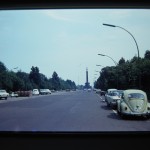 It was interesting to see that it still seems to be possible to park all day free of charge on the road near the Siegesäule, which is only about one mile from the Brandenburg Gate and Reichstag. There are plenty of spaces as well.
It was interesting to see that it still seems to be possible to park all day free of charge on the road near the Siegesäule, which is only about one mile from the Brandenburg Gate and Reichstag. There are plenty of spaces as well.
Next on the agenda was a proper look at the Brandenburg Gate, taking in the River Spree on the way. Unlike many European capitals Berlin does not have a grand river like the Thames, Seine or Danube, but has to make do with the Spree, which is about as imposing as its name.
European capitals Berlin does not have a grand river like the Thames, Seine or Danube, but has to make do with the Spree, which is about as imposing as its name.
The Wall stood just yards in front of the Brandenburg Gate, which was marooned on the ‘wrong’ side when I took my 1967 photograph. The most surprising thing is how low the Wall was then, and it was not until some years later that it was increased to its standard height of 3.6m (almost 12ft) and reinforced in other ways. The gate itself is little changed from my previous visit.
 Having seen the old city centre around Alexanderplatz I decided to revisit what had been the heart of West Berlin in Charlottenburg. This proved to be more difficult than I expected due to the underground work, and I wasted a great deal of
Having seen the old city centre around Alexanderplatz I decided to revisit what had been the heart of West Berlin in Charlottenburg. This proved to be more difficult than I expected due to the underground work, and I wasted a great deal of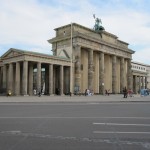 time trying to understand the public transport system in its temporary form.
time trying to understand the public transport system in its temporary form.
Ultimately I arrived at the Kurfürstendamm and went in search of the Kaiser-Wilhelm Gedächtniskirche (Kaiser-Wilhelm Memorial Church), which is one of Berlin’s best known monuments. The tower was preserved in its ruined condition after the war, in the same spirit as the old Coventry Cathedral, and I had photographed it 1967. After a while I was sure I had found the place from which I took the photograph, but to my astonishment the church was nowhere to be seen. How could this be? Eventually I discovered it inside what appeared to be an aluminium and glass skyscraper office block, where it is being restored to its immediate post-war ruined state.
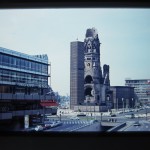 The church is on one side of a large square, and opposite to it was a building also undergoing renovation, covered by an immense hoarding about 100 yards long with huge pictures of David Beckham in his underwear. The church must be only
The church is on one side of a large square, and opposite to it was a building also undergoing renovation, covered by an immense hoarding about 100 yards long with huge pictures of David Beckham in his underwear. The church must be only too pleased to be hiding inside its ‘office block’. The building behind the hoarding will be a branch of H&M, and all the well-known retail names plus many international purveyors of goods to the moneyed classes have outlets in this part of town. Whereas Alexanderplatz has all the style of a typical British new town shopping centre, parts of the Kurfürstendamm are more Tunbridge Wells. Even so, it is likely that some of the upmarket businesses will drift away to Unter den Linden eventually.
too pleased to be hiding inside its ‘office block’. The building behind the hoarding will be a branch of H&M, and all the well-known retail names plus many international purveyors of goods to the moneyed classes have outlets in this part of town. Whereas Alexanderplatz has all the style of a typical British new town shopping centre, parts of the Kurfürstendamm are more Tunbridge Wells. Even so, it is likely that some of the upmarket businesses will drift away to Unter den Linden eventually.
The only shops in which I actually spent any time were the vast Saturn multi-media store, where I wandered about wishing I was 17 so that I could understand what I was looking at, and a bookshop. It was interesting to see how many books there were on the subject of Germany’s economic situation, including some which dared to raise the question of Germany leaving the EU, which would have been unthinkable at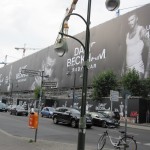 one time. Books about personal development also seem to be quite popular, and one had the title that I would translate as “I Don’t Know What I Ought to Want”, which leaves one wondering how the author ever managed to get round to writing a book at all.
one time. Books about personal development also seem to be quite popular, and one had the title that I would translate as “I Don’t Know What I Ought to Want”, which leaves one wondering how the author ever managed to get round to writing a book at all.
Another struggle with the public transport and a meal at Nordsee, a fish restaurant where other poor people go to eat, and I was back at the Lebensquelle.
Despite the supposedly excellent public transport, one thing I had noticed about Berlin was the vast number of bicycles and motorcycles everywhere. During the working day the pavements in the city centre were lined with 2-wheeled machines parked usually on a strip adjacent to the kerb, and there is a far greater tolerance of motorcycle parking than in Britain. Bicycles can be hired all over the place, and as I wanted to venture some way into the suburbs the next day this seemed to be a sensible way to travel.
Tuesday
The hotel had a few bicycles for hire, but with one exception these had enormous frames, presumably for Dutch guests, and the odd one had its seat set far too high for me. I attempted to resolve this problem, but without knowing the Russian for “Can you lower the saddle, please” it was clear that I was not going to get anywhere.
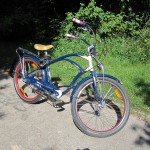 In the end I obtained a bike from a place near Checkpoint Charlie, and it was a dreadful American style cruiser, with massive wide handlebars and a back-pedal brake, which is extremely awkward in traffic.
In the end I obtained a bike from a place near Checkpoint Charlie, and it was a dreadful American style cruiser, with massive wide handlebars and a back-pedal brake, which is extremely awkward in traffic.
Generally Berlin is well set up for cycling, being mainly flat and many streets having a red strip on the pavement for cyclists. There are often separate traffic lights for cyclists at junctions, with slightly different timing from the main ones. The Germans ride their bicycles with the same grim determination as they do everything else, and I felt more under threat from other cyclists than from the general traffic.
My first port of call was the Classic Remise classic car centre in the western suburbs. This is one of several in Germany, and a concept that, surprisingly, does not exist in England. Under one roof it provides classic car storage (in large glass boxes on two levels), workshops, dealer sales areas, showrooms for new sports cars and motorcycles, and a restaurant. During normal working hours anyone can just wander in and look around, and it is like a constantly changing museum.
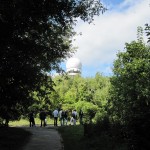 Berlin is generally flat, but I was intrigued by one of the highest hills in the city, called the Teufelsberg (Devil’s Mountain), because it is entirely man-made. It is one of a number of Trümmelberge (rubble mountains), built out of the rubble left by the devastating bombing towards the end of war. Between 1950 and 1972 up to 600 lorry loads of rubble were taken to this site every day, and the final total was 34,000,000 cubic yards. When I set off in search of it on my bike I was expecting to find a mound in the middle of a park in the Grunewald, but eventually found myself slogging up a long steep hill in a large area of woodland. At the top, which I did not quite reach, was a ruined radar station and far under the ground is said to be a Nazi military-technical college built by Albert Speer, Hitler’s architect. The allies tried unsuccessfully to blow it up and decided it would be easier to cover it with rubble. One day in the distant future I am sure archaeologists will quite literally have a field day on this site.
Berlin is generally flat, but I was intrigued by one of the highest hills in the city, called the Teufelsberg (Devil’s Mountain), because it is entirely man-made. It is one of a number of Trümmelberge (rubble mountains), built out of the rubble left by the devastating bombing towards the end of war. Between 1950 and 1972 up to 600 lorry loads of rubble were taken to this site every day, and the final total was 34,000,000 cubic yards. When I set off in search of it on my bike I was expecting to find a mound in the middle of a park in the Grunewald, but eventually found myself slogging up a long steep hill in a large area of woodland. At the top, which I did not quite reach, was a ruined radar station and far under the ground is said to be a Nazi military-technical college built by Albert Speer, Hitler’s architect. The allies tried unsuccessfully to blow it up and decided it would be easier to cover it with rubble. One day in the distant future I am sure archaeologists will quite literally have a field day on this site.
From here I cut across through the suburbs to Charlottenburg and pushed the bike for the whole length of the Kurfüstendamm. It had not been a stunningly exciting day, but I had ridden about 20 miles and seen a good cross section of the city.
Wednesday
One place I had to visit on my final morning in Berlin was the Wall Museum at Checkpoint Charlie, which tells the story of the Wall from start to finish, with the political background and its effect on people’s lives. It was founded in 1962 and although somewhat amateurish in its presentation it is highly regarded for its integrity. There are numerous examples of the methods people used to escape from the Russian sector, ranging from vehicles with concealed compartments to balloons, hang-gliders, and even a submarine. It is all a bit cramped and claustrophobic, but perhaps that is not a bad thing, and there were certainly a large number of young people making notes on their Ipads.
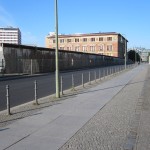 From there I walked westwards, aiming for the German Technical Museum, which is in a remaining part of the Anhalter Bahnhof (Anhalter Station), and on the way came across the longest standing length of the Wall in Central Berlin, along one side of Niederkirchner-strasse. The Wall here is the standard height of 3.60m with the curvature at the top to make it hard to climb, although it has a lot of holes.
From there I walked westwards, aiming for the German Technical Museum, which is in a remaining part of the Anhalter Bahnhof (Anhalter Station), and on the way came across the longest standing length of the Wall in Central Berlin, along one side of Niederkirchner-strasse. The Wall here is the standard height of 3.60m with the curvature at the top to make it hard to climb, although it has a lot of holes.
Before the war Anhalter Bahnhof was one of the busiest stations in Berlin, with connections all over eastern Europe. The Iron Curtain made it largely redundant, and it was finally closed in 1952. Sadly, it was also one of the main stations from which Jews were transported to the concentration camps in the east, and there is a plaque commemorating that on the entrance portal, which has been preserved in isolation. From the portal down to the Technical Museum is quite a long walk, with traces of the old platforms, rails and embankments visible here and there along the way.
platforms, rails and embankments visible here and there along the way.
One thing Berlin does need is a new airport, and it will get one in 2013. When I booked my easyJet flight from Gatwick in April 2012 my ticket was made out to Berlin Brandenburg. Just a couple of clicks on the internet revealed that Berlin Brandenburg was a very long way behind schedule and would not open until June 2013, leaving me wondering how much compensation I would get for being kept waiting for 14 months at Gatwick. Needless to say, revised tickets appeared within a short time, made out to Berlin Schönefeld.
Schönefeld falls very far below the standard expected for an airport of one of Europe’s leading capital cities. On the way to and from the city centre the S-bahn travelled right alongside the old Tempelhof Airport, which was the mainstay of West Berlin during the Cold War years and continued to be used until 2008. It is now a city park, and on the bright Sunday afternoon when I arrived the former runways and grass areas were being put to good use by families enjoying themselves. The terminal buildings were visible on the far side of the airfield, and I had forgotten how big they were. The main building is almost a mile long, curving round a corner of the field, and at the time of its construction just before the war it was one of the largest buildings in the world. It was part of Hitler’s grand plan for Germania, a super city to be the capital of the Third Reich in its ultimate form. Viewed from above the terminal complex was supposed to look like an eagle in flight, although I would not have guessed that if I had not read it. No decision has been made about its future use.
It is difficult to understand why, but Berlin is different from other large German cities, somehow less hectic and more parochial. Perhaps it is because it went for so long after the war with an uncertain future and limited investment until recently, but I felt that it would not be a bad place to live.